I recently picked up several Swiss rifles from Simpson Ltd (who has a who bunch of them, and all listed individually so you can choose the exact rifle you want). The Swiss used an evolving series of straight-pull rifles and carbines from 1889 into the 1970s, when the last K31 carbines were finally retired from service. The Swiss, of course, have always taken national defense and neutrality pretty seriously, and I’ve been wanting to add some of their rifles to my personal collection.
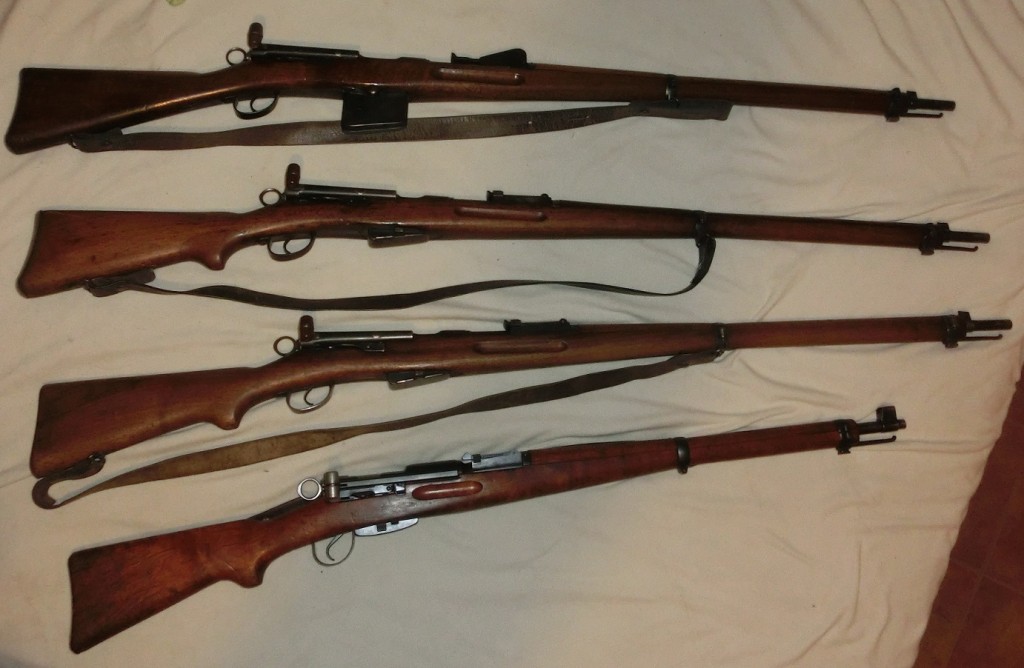
The four I picked out were a pretty good overview of how the design evolved. The first is a Gewehr 1889 – the rifle that replaced the turnbolt Vetterli rifle. The 1889 has a 12-round magazine and used a semi-smokeless cartridge, the GP90 (GP1890, not to be confused with the 5.56mm GP1990). It uses a heavy round-nose 7.5mm bullet, pushed at relatively low velocity by modern standards. The magazine was permanently attached, with a lever allowing it to be dropped just below the line of the bolt, to act as a reserve while the rifle was fired as a single-shot.
The second rifle I got is an 1896/11 model, which is the peak of the design from a precision shooter’s perspective (I think). The Swiss military realized the ballistic deficiency of the round-nose GP90, and developed a smokeless powder, higher pressure, spitzer-bullet cartridge in 1911. Many of the Model 1889 rifles had already been strengthened in 1896
by moving their locking lugs up closer to the chamber, and it was determined that a simple rebarreling would allow them to shoot the new cartridge. A great many were subsequently converted into the 96/11 pattern. In addition to the new barrel, the conversion replaced the magazine with a new 6-round detachable type, added a semi-pistol grip to the stock, and replaced the sights.
In addition to striking me as a very sleek and attractive looking rifle, it has several subtle features showing that its designers were very familiar with the needs of a serious precision shooter. The Model 1889 had some of these, but the 96/11 really shines. To wit:
- The muzzle has a recessed crown to protect it from damage
- The barrel is encircled by a metal tube under the front barrel band. This isolates the barrel from pressure from the stock. It’s not free-floated, but it’s getting close.
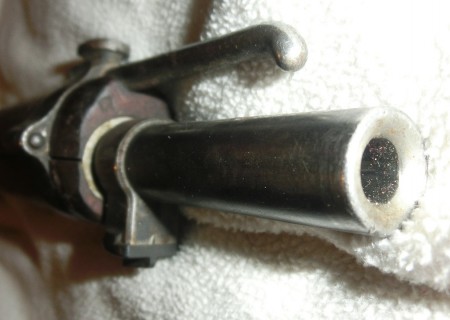
- The front sight blade is carefully squared off, and tapered to be widest at the rear. This provides an excellent sight picture, especially compared to the indifferent triangular pointed front sights on many Mauser variants.
- The front sight blade itself is mounted on a large dovetailed base, making it easy to adjust to set windage.
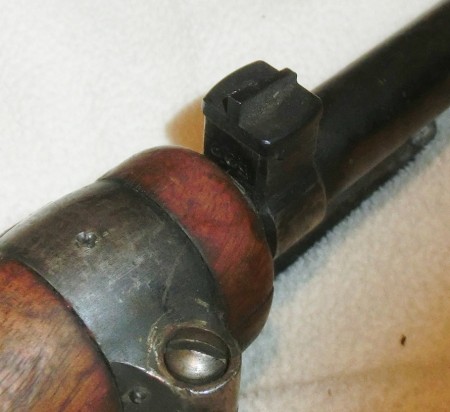
- The rear sight notch is cut to a sharp-cornered square, giving a very clear sight picture.
- The semi pistol grip gives a very good grip for the firing hand.
- The exaggerated hook shape of the trigger allows the shooter to maintain a consistent finger placement through the trigger pull.
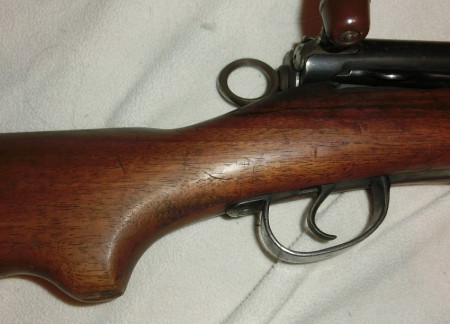
- The trigger pull itself is an outstanding two-stage type, with the final release being both crisp and light.
- The straight-pull action is wonderfully smooth (better than the K31 action).
- The length of pull is just right – for me, anyway.
- The butt of the stock is nice and wide to soften the recoil impulse.
- The Swiss 6-round charger clips encapsulate the cartridges, thus negating the need to put a lot of spring pressure on the rims like most stripper clips. As a result, they are smooth and easy to use (unlike so many stripper clips).
I am really looking forward to getting this rifle out to the range!
The third rifle I got was a Gewehr 1911. When the 96/11 design was formalized, more rifles were needed than could be made by converting older existing guns – so 1911 pattern rifles were also manufactured from scratch. These are virtually indistinguishable from the 96/11 – the one giveaway is that a 96/11 will have the semi pistol grip spliced into it originally-straight stock, while the 1911 will have the grip as an integral part of the stock.
There were also carbine-length version of the 1911 made, under the designation K11 – but I don’t yet have one of those. They are reputed to be the least-accurate of the Swiss rifles, simply because they have the shortest and lightest barrels. Still, after seeing the quality and attention to detail on the Gewehr 1911, I will definitely be adding a K11 to my collection sooner or later.
Lastly, I got a K31 carbine. With this design, the bolt was redesigned, in a fairly significant departure from the original Schmidt mechanism. The new design (which was the brainchild of Major Furrer, who was behind several other Swiss arms designs) was almost half the overall length of the 1911 pattern bolt. This allowed the same overall length of carbine to have a barrel several inches longer, and also be both stronger and less expensive to manufacture. Quite a deal for the Swiss government! I was expecting the K31 to build on the rifleman’s qualities of the 96/11, and was a bit disappointed to find that it did not – at least in my impression. The K31 has a few improvements beyond the length and bolt strength, including a rear sight graduated down to 100m (the 1911 pattern starts at 300m), and a set of hefty protective ears around the front sight. However, I find the length of pull to be a bit too short for comfort, and the redesigned bolt is not as smooth to operate.
We will definitely be doing a video comparing all of these models both disassembled on the shop table and out at the range!

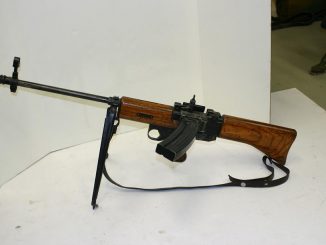
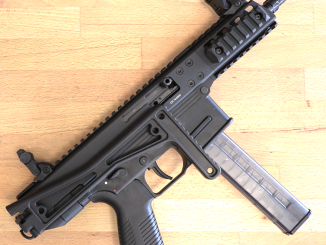
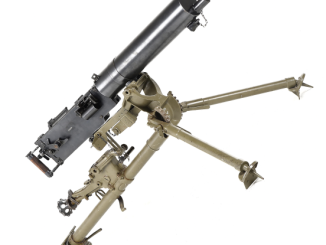
I would like to point out, because it was never made clear to me until I handled one, that the cocking ring on these Swiss straight pulls make it so you CANNOT cycle the action while maintaining a cheek weld to the stock. I held a K31 to my shoulder, sighted, pulled the action open, and promptly busted myself in the eye with the rather narrow cocking ring as soon as the camming handle had unlocked the mechanism, which hurt like hell.
Nobody ever points that out. I just thought I would. Otherwise, the rifles are very well made, and excellent values. Supposedly, either the 1911 or K31 models were salt bath nitrided (Melonite/Tenifer/Wasp, etc) on their actions and barrels, making them extremely durable and long wearing, as well as corrosion resistant.
Yep, that’s a good point about the cocking ring and cheek weld.
Ha-ha! In my case, using a Modell 1911 Schmidt-Rubin 7.5x55mm Langgewehr, I about nearly broke my nose! Ouch!
Matthew and David,
Thanks for sharing! Nice to know there are others out there who share my pain.
I’ve found it to be only nearly the case with my G11; I’ve got about 1/4-1/2″ of room between my eye and the cocking ring with where my head sits on the stock, so I can cycle the bolt without breaking the sight picture. It is a bit tricky, and I’ve got to be very careful to avoid giving myself a very strangely shaped black eye.
Ian –
As a left hander, you might be interested to know that a Swiss gunsmith, Buergin, made a clever left hand conversion for the K.31 bolt called a “linksriegel”. You can order them directly from several different Swiss suppliers. I got mine here:
http://www.swissdagger.com/
Thanks for the review, Ian. I have two K-31’s and a Schmidt-Rubin M1896/11, and have my eye on a K-11 ( carbine version of the 1911 rifle ).
While I largely agree with your initial assessment, I personally find the K-31 to be generally better than the already superb 96/11. My K-31’s are extremely accurate, with an LOP that suits me just fine. Mechanical action of the bolt in one K-31 feels on par with that of the 96/11, while the other is slightly smoother. I also like the added mechanical strength incorporated in the K-31 design ( not that the 96/11 wasn’t already heavily engineered in that respect ).
Of course, these are small details that are probably a matter of individual user preference and ergonomics, plus tiny tolerance variations in individual guns, so I’m just sharing my own experiences with these rifles.
One of many things I really appreciate about Simpson’s is that they post an exact description of each individual gun and details of its condition and status ; you know exactly what you are getting. They also post the measured inside diameter of the muzzle so the buyer has an idea of the amount of barrel wear for each gun.
Hey, boyz….. I have a k31, in mint conditions like out-of-the-box, hi (of course, being in Italy I also paid it VERY mint, approx 3x yr US price :-(( – all in all a good weapon, the straight pull always drops an empty case almost exactly on your head, so I recommend you wear a cap with visor. One main trouble is the gauge… sharp 7,5 mm… if you are using 7.62 mm, do not stress the barrel by shooting too many rounds one after the other. Ammo is crucial anyway also in case you use original swiss surplus ammo, they get you to very accurate shooting but they wear out your barrel anyhow, being bullets made out of a funny tombac alloy, same as originally used on italian ’91 Carcanos. I am left-handed and once read on a magazine that the action may be switched to LH with 20 mins of lathe labour, then I moved 3 more times and was no longer able to find the magazine where the (precious) piece of chronicle was written… 🙁
Keep up guys,
Normann, Please see post by John D. above for a nifty left hand conversion for the K.31 bolt.
It would be interesting too see match of this Swiss rifle against Ross rifle against Lee-Navy rifle against Mannlicher rifle to compare these four straight-pull-bolt-action military rifles.
–
I wonder why the 12-round magazine was replaced with 6-round one? It is technical reason for this change or it was simple done without technical reason?
–
Note that the 7.5×55mm Swiss was first military rimless cartridge and ahead its time with their small-bore bullet (when compared to other contemporary rifles).
Correction: the first military rimless cartridge was German Patrone 88 for M1888 rifle, but still remember that the majority of countries uses rimmed ammunition after the swiss 7.5x55mm enter to service.
My understanding is that the Swiss determined that it took the same amount of time to load 12 rounds with two clips as to load a 6-round mag with one clip, twice.
A straight-pull comparison would be a neat thing to do – I’ll have to see if I can set that up…
Ian, if you spend any serious range time with them, you are about to fall in love. My scope 96/11 is my most accurate rifle. It is a 1/2 MOA gun, and I have shot groups as small as .259″ with it.
Great observation — I concur!
The first K-31 I bought aroused the interest of one of the fellows at my local FFL dealer, who is an avid vintage firearms collector. He was very impressed with the obviously high standards of craftsmanship and utility evinced by that rifle, so when the time came for me to consider purchasing the second K-31, he decided he would get one too. My understanding since then is that he definitely considers his K-31 a complete “keeper”, not to be parted with under any circumstances. He let the owner of the dealership ( who was primarily a “black gun” enthusiast with only a secondary interest in vintage firearms, and then mostly from a business standpoint ) try it out one day at the range, and now that gentleman is apparently a believer.
Nice to know that there are more people now who understand and appreciate the Swiss rifles, especially when it dawns on them that the example they are holding was built as an infantry ( battle ) rifle designed to survive the harshest environmental conditions on the battlefield and keep on functioning, yet is capable of the sort of consistent accuracy with standard ball ammunition that modern shooters pay thousands of dollars for in terms of custom-built or customized, accurized National Match grade rifles firing expensive special ammunition and utilizing top-of-the-line scopes as well as other accessories. There is a lesson in here somewhere.
My K31 is the second rifle I ever bought, and while actually I’ve yet to sell any of my rifles (done some selling and trading of pistols, though), I can conclusively say the K31 is never going to leave.
I seem to recall reading somewhere that if the K31 were put back into production for civilian sale today and made to the same quality standards as the originals, it would have to retail for upward of $2000 to turn a profit. I spent $200 on mine, which was about the going rate at the time.
I tend to classify the Swiss straight-pull bolt actions as “phony” straight-pulls, in that they are actually turnbolt systems using a cam to operate the bolt via the “straight-pull” gadget. The Canadian Ross and Austrian M1890/95 Mannlicher also fall into the same category.
The M1889-K31 family are basically Mauser-like turnbolt arms with the unnecessary complication of a parallel “bolt” system and cam to accomplish the function of the simple bolt handle on a Mauser-type rifle.
About the only “straight-pull” bolt actions which aren’t set up this way are the Austrian 1886 Mannlicher and the America 1895 Lee, both of which use a cam-locking system. I’ve long suspected that the Mannlicher 1890/95 system, which is not the same as the 1886 system, was developed to deal with the standard problem of most “non-rotating” bolts, namely poor primary extraction to break the cartridge loose from the chamber walls.
About the best thing that can be said of all the straight-pulls, “phony”, “legitimate”, or whatever, is that they pointed the way to practical self-loading actions, usually gas-operated. The Austrian M1886 lockup was a forerunner of the FN FAL, and the Swiss straight-pulls operate much like the U.S. Garand and M1 carbine, which are both fundamentally cam-operated turnbolt designs.
As manually-operated rifles, they’re fascinating gadgets. But generally, adding unnecessary complication to a rifle mechanism intended for combat isn’t really a terrific idea.
cheers
eon
What do you think about Chas. Newton Leverbolt rifle.
https://sites.google.com/a/iroquoisarmscollectors.org/iroquoisarmscollectors/home/newton-arms-co/newton-leverbolt
It reach only prototype stage, but the lack of mass production was due to economical condition in Unites States around 1929. Can it be a feasible hunting rifle? (not military as it was never intended to this role).
I like that Newton leverbolt Daweo, is it straight pull “straight back” or do you move the bolt handle during said motion?
The bolt handle is pulled “up” and “back”, in roughly the same motion as the Lee Navy bolt handle;
http://world.guns.ru/userfiles/images/rifle/US/1343415595.jpg
The difference is that, in the Lee, this motion raises the rear end of the bolt enough to cam the locking wedge (that thing under the rear of the square bolt body) up and out of its recess in the receiver. In the Leverbolt, it turns the small came sleeve shown in the drawing against a cam path in the left receiver wall, enough to rotate the bolt out of lockup. Essentially the Ross system, in that respect.
Exactly why Charles Newton (or whoever) came up with this I don’t know. It’s more complicated than the regular turnbolt Newton rifle action and probably more expensive to machine for that reason.
Still, it’s an interesting gadget.
cheers
eon
I don’t know anything about the Leverbolt – definitely a knowledge gap to fill in!
Thanks, Daweo. That’s one Newton I’ve never heard of.
The “Buffalo Newton” mention in the article indicates it came near the end of the Newton production runs. Newton rifle production at that time was indeed licensed to Marlin.
The bolt system is an interesting “crossbreed”. The bolt handle works much like that of the Lee Navy 6mm built by Winchester, but the actual bolt operation is closer to the Ross. Note the trademark Newton multiple-lug “interrupted screw” locking system in the diagram, working much like the breech-lock of a heavy naval gun. The “regular” Newton rifle was a turnbolt similar in concept to the later Weatherby.
I’m wondering if any Leverbolt rifles were ever actually produced. Even a toolroom example would be interesting to examine.
cheers
eon
Here: http://www.thefirearmblog.com/blog/2009/01/31/newton-leverbolt-rifle-the-bolt-and-lever-rifle-has-had-a-child/ you can find image of Newton Leverbolt rifle so I can say no less than 1 was made.
Like the M14 Eon, it twists the case inside the chamber prior to extraction apparently.
That’s the primary extraction part of the opening stroke. That “twist” is why turnbolt systems generally don’t need lubricated or waxed cases, etc., as long as the system has enough “dwell time” to allow the breech pressure to drop far enough to let the case “relax” slightly. In manual bolt systems this is “automatic”, as the shooter can never open the bolt fast enough to “beat” the pressure drop.
In self-loading systems, it depends. Blowbacks often have this problem, especially in heavy calibers, the Hispano aka AN-M2 aka Oerlikon aka Becker 20mm cannon being the classic example. Several Japanese and Italian LMGs and a couple of HMGs from the WW2 period required oiled cartridges due to poor primary extraction, regardless of their operating systems.
Some non-rotating bolt arms beat the problem by using a fluted chamber to “float” the cartridge on a layer of gas; the recoil-operated H&K rifles do this. Pistol-caliber weapons like SMGs rarely have this problem at all due to lower operating pressures. Some that might, notably Magnum-caliber autopistols such as the AutoMag, Wildey, Desert Eagle, etc., do have rotating boltheads at least partly for this reason.
Generally, any design with high-pressure ammunition is best built with a rotating bolt or at least bolt head, or have some other method to break pressure adhesion in primary extraction, just to be on the safe side.
Otherwise, count on needing to use a case extractor- a lot.
cheers
eon
Oh right, well you learn something everyday as they say he he.
“Some non-rotating bolt arms beat the problem by using a fluted chamber to “float” the cartridge on a layer of gas;”
ShKAS aircraft machine gun also has grooved chamber despite it use regular* rifle ammo – 7.62 Mosin, but it was grooved rather due to big rate-of-fire (1800RPM) than the cartridge power.
*actually the special with head-stamped Ш (Sh)-letter were delivered for ShKAS, because the regular with ammo ShKAS don’t work reliable (it is not surprising when consider that 7.62 Mosin was designed for repeating rifle).
You are quite correct, Daweo, about the ammunition designated for the ShKAS aircraft MG being of a special, enhanced, close-tolerance version of the standard 7.62mm x 54R cartridge. The ShKAS’ high firing rate demanded that much more in the way of precise tolerances and performance from its ammunition.
On the obverse side of this subject, it has been said that Soviet snipers armed with the Mosin-Nagant M91/30 often used ShKAS “seconds” ( rounds rejected by line inspectors for the slightest perceived blemish or flaw ) quite successfully as match-grade sniping rounds. However, I have also read from more than one reliable source that the use of such “seconds” was generally discouraged due to the higher chamber pressures generated by the ShKAS cartridge.
I have a 1911 and a K31. One thing I found was that they are picky about what you use to lubricate them with. I’ve found mine to work well with Grease, Automotive and Artillery found surplus from our very own US Army. Yeah, just about anything will work, but the GAA grease makes these function really nicely!
When you take them apart you will find the typical period use of as few parts as possible design within the constraints of making the system work. Not many pins to loose and most parts interlock to stay together. Also you will find the finest machine work you’ve ever seen in a military rifle. That fine machine work would, I think, make it a poor rifle in standard combat conditions.
Have fun!
Scott
Hi Scott,
I think “normal battlefield conditions” is one of the common misconceptions which us outsiders have of Swiss defense.
Where our politicians enslave an entire generation to send them off on some grand plan, for the whole bunch of poorly trained youngsters to act as cannon fodder…
The Swiss don’t have those narcissists(or at least they deny them any power). They have a confederation of county sized independant states. The central government is tiny and they allow that fe’ral government virtually no powers. Effectively, There is no Swittzerland.
At the Canton level, although government power is increasing, much of the policy is still decided by referenda of all citizens.
Swiss are not therefore sent off on grand schemes of imperial conquest, they plan to defend near their homes, and – having saved their money, since their last war (with napoleon!)instead of squandering it on disastrous foreign wars.
They have invested extensive prepared positions, including vast secret tunnels, All roads and bridges are built with chambers to receive landmines and demolition charges, there are likely inviting alternative routes leading to ambush sites. The Swiss also know their area of operations intimately.
The ones getting their guns muddy would be any aggressors stupid enough to enter the Helvetic Confederation.
forgot the link to “There is no switzerland” http://propertyandfreedom.org/2014/01/robert-nef-understanding-switzerland-and-the-swiss-pfs-2013/
Really a study in contrasts in build quality over the past couple days:
Sunday: VG1 about as simple as a bolt action gets!
Monday: Swiss Schmidt-Rubin straight pull about the most finely crafted service rifle?
A straight-pull “shootout” would be an interesting comparison: Swiss papier-maché and sheet metal six-round chargers vs. Ross stripper clips vs. Mannlicher en-bloc “this side up” clips vs. Winchester Lee 6mm charger clips… Of course, only 7.5×55, .303 and 8x56r ammunition is commonly available these days, no?
I do know a guy who handloads .236 Lee Navy for his 1895 Lee, and we’ve been meaning to take it to the range…
I have a K31 and love to shoot it. I typically use the surplus Swiss ammo in matches and the Privi stuff when plinking. I see “cautions” on various blogs/websites about using the “modern” 7.5×55 in the 1911 – something about the receivers can’t take the pressures of modern ammo? Or does this apply to another Swiss rifle. I ask as Ian intends to take both rifles to the range and I don’t wish to see an article about a rifle going “boom”.
I haven’t gotten poked in the eye – yet. I need to concentrate on whether or not I’m lifting my cheek. I guess I am. Running 10 rounds through it in 60 seconds during rapid prone is a blast.
Everything authoritative that I can find says that standard GP11 ammo is perfectly safe in the 96/11 and 1911 models. Common sense says so too, since the rifle was adopted the same year as that cartridge. I think the cautions come from the model 1889 rifle, which is only rated for the lower-pressure GP90 cartridge. Later on, different versions of the GP90 were adopted using smokeless powder, culminating in the GP90/23. That allowed the 1889 rifles to remain in rear echelon or training service with modern but still safe ammo. It is possible to chamber the high pressure GP11 in the older rifles, though, and that is where the legitimate safety issue lies (although I believe the Swiss did allow use of GP11 in the 1889 rifle as an emergency measure).
There is no reason that a 1911 rifle design can’t be just fine with modern high-pressure ammo – consider the 1903 Springfield in .30-06.
Thanks for the clarification Ian.
I will second Ian’s reply to you concerning the use of the lower-powered 7.5mm GP90 cartridge in the M1889 model rifles. Typically, the M1889 rifles were manufactured with the bolt locking lugs about three-quarters of the way up the length of the bolt, and they locked into machined recesses in the sides of the receiver housing ; the M1896/11 rifles moved the locking lugs ( and opposing recesses ) lower down closer to the chamber ( about halfway down the length of the bolt ), resulting in much greater mechanical and structural strength. Finally, in the K-31, the locking lugs were moved all the way downstream to the forward end of the bolt at the chamber itself ( as is typical of modern practice ) to ensure maximum strength, period.
For all those interested, there is a very good compilation of technical explanations, complete with photographic illustrations and numerous links to related subjects on Swiss rifles, at http://www.swissrifles.com. There are very clear illustrations of the differences in the bolts that I mentioned above, as well as lots of other intriguing historical and technical data.
Neat article. After I pay off my Comblain, I think I’ll try and get one of the 89/11 models. Sounds really neat. Oh, and Ian, do try to reply on the ammo issue brought up by Tom. Such warnings are often issued by people who think that anything made before their lifetime is junk, and unsafe. But, in case there is something to this, we would all like to know. Thanks. mikey
There is something to this ammo thing, but its gotten a bit out of hand. The early (pre 1911 or mod 86/1911) rifles had their locking lugs at the back of the locking sleeve and, as such were a bit weaker than the newer ones with the locking lugs at the front of the sleeve. In what became the 1911 the rifles were strengthened and the cartridge was changed to what is now in use. The problem is that the newer cartridge will chamber and fire in the older rifles, so you have to watch out there. Another problem is that in reloading for the 7.5×55 they really mean it about the 7.5 part. The bores are more like .307″ than the .308″ we are used to for 30 caliber rifles (30-06, 308 etc.). With that in mind you can see that reloading for these rifles can have problems if one isn’t careful. You can use .308 bullets, but you have to start low and creep up the charge carefully. If you want a really stout load try the Norma ammo, it’ll let you know when you’ve pulled the trigger!
I have had a K-11 for over a decade.
In Oz, GP-11 ammo is a collector’s item these days. The Privi-Partizan ammo is good, but expensive and supply is a bit random, so it’s handloads or nothing. I hand-load using Privi cases. Before these showed up, I used .284 Win brass reformed in a 7.5 Swiss FLS die and using a .308Win size shell holder. These fired well, but, because of the smaller “standard” rim diameter, extracted OK, but usually failed to eject correctly, if at all.
I started playing around with 155 SMKs which worked fine but, at that point, also made an interesting discovery.
A friend with a nice new K-31 tried the same SMK load and could not get the rounds to chamber, with one getting stuck in the throat of the barrel; lotsa fun!
Here’s why:
The G and K 11 barrels are throated so that they will also chamber and fire the old Type 96 “torpedo” bullets, as there was a LOT of that ammo in store in 1911. Thus the LONG throat in the barrel. (Not unlike the long throats in .303 Brit barrels for decades after Mk 6 ammo had been superseded in 1912″. See also .30-03 vs .30-06.
Interestingly, the GP-ll ammo, introduced at about the same time as the 1911 arms (unsurprisingly), has a SECANT ogive; as opposed to the TANGENT ogive of the Sierra-type bullets.
By the time they got to the K-31, the old ’96 ammo was pretty much a novelty collectors item, so K-31s have a VERY short leade / throat, to optimize the engagement with the GP-11 bullet. This is why they “choke” on SMKs. You NEED a bullet with a SECANT ogive like some of the Hornady jobs, or for us here in Oz, the locally made, 155gn BJD brand HBC (High Ballistic Coefficient) bullet. These were designed for long-range Full-Bore (High Power) target shooting, but with their light jacket and large void behind the small hollow-point, they are pretty good on deer and feral pigs, whether fired from a K-11 or driven a bit harder from a .30-06.
As for “bore size”. one thousandth of an inch is neither here nor there as far as pressure goes; a LOT of target rifle barrels are deliberately made with .299″ bores and even .307″ groove size. This ensures complete gas-seal and surface bearing for the bullet. It also ensures that the bullet engages the rifling “concentrically”. Eccentric bullet engagement leads to bullet distortion and excessive precession on launch, resulting in larger groups down-range. “Undersized” bullets belong in muzzle-loaders firing soft lead Minie balls, not “nitro-fuelled” centre-fires launching bullets at nearly (or over) Mach 3.
It’s been a number of years since I’ve shot my Swiss….but it was a pleasure. Kinda like haveing a Swiss watch that shoots!! Pure shooting pleasure.
You’ve said it very well, indeed!
The military-surplus 7.5mm x 55 GP11 round is fantastic — clean-burning with predictable and manageable recoil, great MV and ME, ballistically efficient, dead-accurate with a flat trajectory at long ranges, and which retains a lot of energy down-range for delivery into the target. Altogether a first-rate Mil-spec cartridge that deserves wider recognition for its qualities.
One difference that hurts the accuracy of the K31 is that they have larger chambers than the 96/11 or 1911 rifles – but use the same ammo. The size difference is to the point that Redding has made two different dies for these rifles. The dies marked 7.5 Swiss are for the smaller 96/11 and 1911 rifle chambers, the dies marked 7.5×55 are for the K31 chambers, and brass re-sized by them won’t fit into the older rifles.
And as far as a lever action turn bolt, yes, the Browning BLR is such a design. Two piece bolt with the locking lugs on the front turning to engage a barrel extension, the main body of the bolt is actually a rack gear moved to the rear by the lever that has an arc of gear teeth.
Collecting in general is fun for me but with Swiss weapons I went a bit over board. My latest purchase is a ZfK-55. Great shooter. Accessories ie: cleaning kits, cardboard loaders, bayonets, etc., are fun with these as well. The evolution of their revolver and Luger designs is also interesting.
Wow, I’d love to have a ZfK55, but that’s outside my price range.
Very nice acquisition , Robert, and a comparatively rare one too. Definitely a “keeper”, and not to be parted with under any circumstances :). Congratulations!
Belated note on Swiss defense diligence… heard on the BBC early this morning that the Ethiopian jet that was hijacked to Geneva by its own copilot did not meet any scramblers upon entering unauthorized airspace because…. um…. the Swiss Air Force keeps costs down by not working nights or weekends. I know frugality is a national attribute of the Swiss, but I suspect that policy may be under review.
For those interested in possibly picking up a nice Swiss M1896/11, M1911, K-11 or K-31 at a reasonable price, Simpson’s ( http://www.simpsonltd.com ) and Classic Firearms ( http://www.classicfirearms.com ) appear to have recently gotten substantial shipments of these rifles and carbines. Classic Firearms also has original Swiss Army issue Field Cleaning Kits for these guns available.
Hope this will prove useful to at least some of you :).
I haven’t been able to get to the range with mine yet and it’s driving me bonkers! I have charger clips and a case of ammo and everything…just things keep coming up that prevent me from getting to try them out. FWIW, my first stop is going to be the 500-yd steel silhouette range – we’ll see just how well these babies can really perform.
Also, what I really liked about Simpson’s was being able to pick out specific rifles, rather than getting whatever one was on the top of the pile. It lets them charge a premium for the really nice ones, but it let me pick out ones with specific characteristics that I wanted (stock repairs to give character, but really good bores and all matching numbers).
Yes, Simpson’s is very much customer-oriented in many respects, over and above the higher standards one could expect even from other respectable vendors.
Hope you get a chance to scratch that itch soon! 🙂
Funny you should mention that today, Earl – I just got back from a trip to the range with the M96/11, M11, and K31. They are all sweet rifles! I definitely need to stock up on more GP11 ammo…
I know this is an old thread and the writing is very nice and informative but things must be straighten out.
First M1889 action is not weak. In fact, it is stronger than Lee-Enfield. So why it cannot handle GP11? The answer is… Its chamber wall is a little thin for the new ammo (M1889 was designed for black powder cartridge). I have read from somewhere that in emergency (war) GP11 COULD BE USED in this rifle.
But why the Swiss waned to update the design? I blame that to the French with their smokeless powder which burn clean and propel the jacketed bullet faster. The negative effect was the new powder also increase chamber pressure. This force the Swiss to upgrade M1889 to M1889/11 with the biggest change was the barrel with thicker chamber wall. Moved the lugs to middle section (the most fore front of the bold sleeve) of the bold was just an effort to make it an inch shorter and slicker. Schmidt refused to redesign the rifle because he did not find any benefit for it. His long bold design made a lot of sense when everyone think reliability is importance. Look again you will see M1889’s bold mechanism is well hidden inside the receiver. In K31, the bold sleeve is exposed that made a lot of experts thinks the rifle is not reliable in trench warfare.
K31 is still a Schmidt design. The next generation Swiss just cut the bolt head off then came up with a new extractor. The rifle was now can be made shorter but less reliable. Thanks god WW1 tactics were long gone.
Why the Swiss went from 12rd mag to 6rd mag? Lot of people at the range including myself take forever to empty that 6rd mag when we want the most performance from the rifle. With accurate rifles and well train men, they just realized that all they need was 6rd mag. This also cut the weight and improve the gun’s balance. This is just my opinion.
A lot of people think M1889/11 is a better gun. I think they just like the worn out triggers and sears on those guns. The barrels also got enough shots to see the best performance with very smooth bores. I think they are too touchy for my liking. On another hand, the K31 grip is too big.
If the bold hit your face when you operate it you must have a very big nose. On the bench and on sand bags, I see it is much easier to weld the butt on my shoulder then pull the bold (some time I see my flat nose is an advantage). Snapping action when you work the bold help. I can do this all day using only my thump and a finger.
Correct me if I am wrong. Thanks.
I have to agree on the fact the 96/11 and 1911 have a few “ups” on the K31. Don’t get me wrong, I love the K31, I own two, but the bolt on my 96/11 long rifle and 1911 carbines do seem to be smoother and more positive if that makes any sense. I also find the slimmer middle section of the stock more ergonomic to me.
I found an 1889 today for $125 at the local NAPA store. Despite functioning like a non-detachable mag, the mag actually comes out readily if you operate the magazine disconnect lever just so. Another thing I noticed is the striker can be released with the bolt unlocked, but the force will lock the bolt for you, before it fires.
Hey guys. I have a friend in need of a magazine for a 1911 I think. They are obviously hard to come by. Any advice on where to look?
Thanks for this post
Thanks for the post
I just slightly rotate my Schmidts to the right while operating their bolts.
My 96/11 has a lot of cosmetic wear, albeit the bore is perfect. I have mounted a Mojo rear sight on my 96/11, and it shoots as a match rifle. At the range I feel as if I’m a designated marksman. My K31 I’ve left as issued as it is almost
100% as new. It also out shoots any other bolt-action with iron sights that I’ve ever fired. Sorry Swedish Mauser dudes!
I’ll bet that Schmidts cost the Swiss more to build than officer’s Lugers.
so Legit Arms shows you everything related to this world to help you decide on the one that best suits your
taste and needs. Please feel free to visit our website
https://www.legitarmsdealer.com/